August and September 2021

The harvest frenzy starts in August and doesn’t let up until October. These months represent the bounty of what we grow, what we harvest and what we preserve for winter.
As I write this in mid-October, I’m ready to put the gardens to bed. Ready for the welcome blanket of snow that signifies my outdoor labor is done until spring.
Welcome to my series documenting life on our 66-acre Vermont homestead, which we moved to in May 2016 from urban Cambridge, MA. Wondering about the financial aspects of rural life? Check out: City vs. Country: Which Is Cheaper? The Ultimate Cost Of Living Showdown as well as my monthly expense reports. Contemplating going rural? Here ya go: Want To Move To The Country? 15 Things To Consider.
Happenings Around Town
Our local hot air balloon festival happened in September. We were out in a field, surrounded by friends and neighbors, watching enormous plumes inflate and ascend.

There’s no new way for me to say how much I love our community. Nothing I haven’t said before: that I’m grateful and connected and happy. But I can’t stop saying it because this is our place. Devoid of most consumerism and traffic, with limited cell reception and lots of friends. I’m thankful we get to live here.
The very next weekend in September brought the county fair. A stereotypically idyllic annual event where pumpkins are given prizes for their size, little kids lead their 4-H cows through the show ring, tractor enthusiasts roll out their antique John Deeres to compete in the tractor pull, and we buy our kids ice cream cones and a carousel ride. A day very well spent.
Croquet
Summer lawn games happened this year with the croquet set I bought for $2 at a yard sale three years ago. The wickets were ignored, the balls flew down the hill, mallets were akimbo and Glamour Shed was there for it all. Croquet: maybe not a game for children. No problem! Kidwoods ended up winning, adherent as she was to the rules, which cannot be said for the rest of us
The Harvest Season
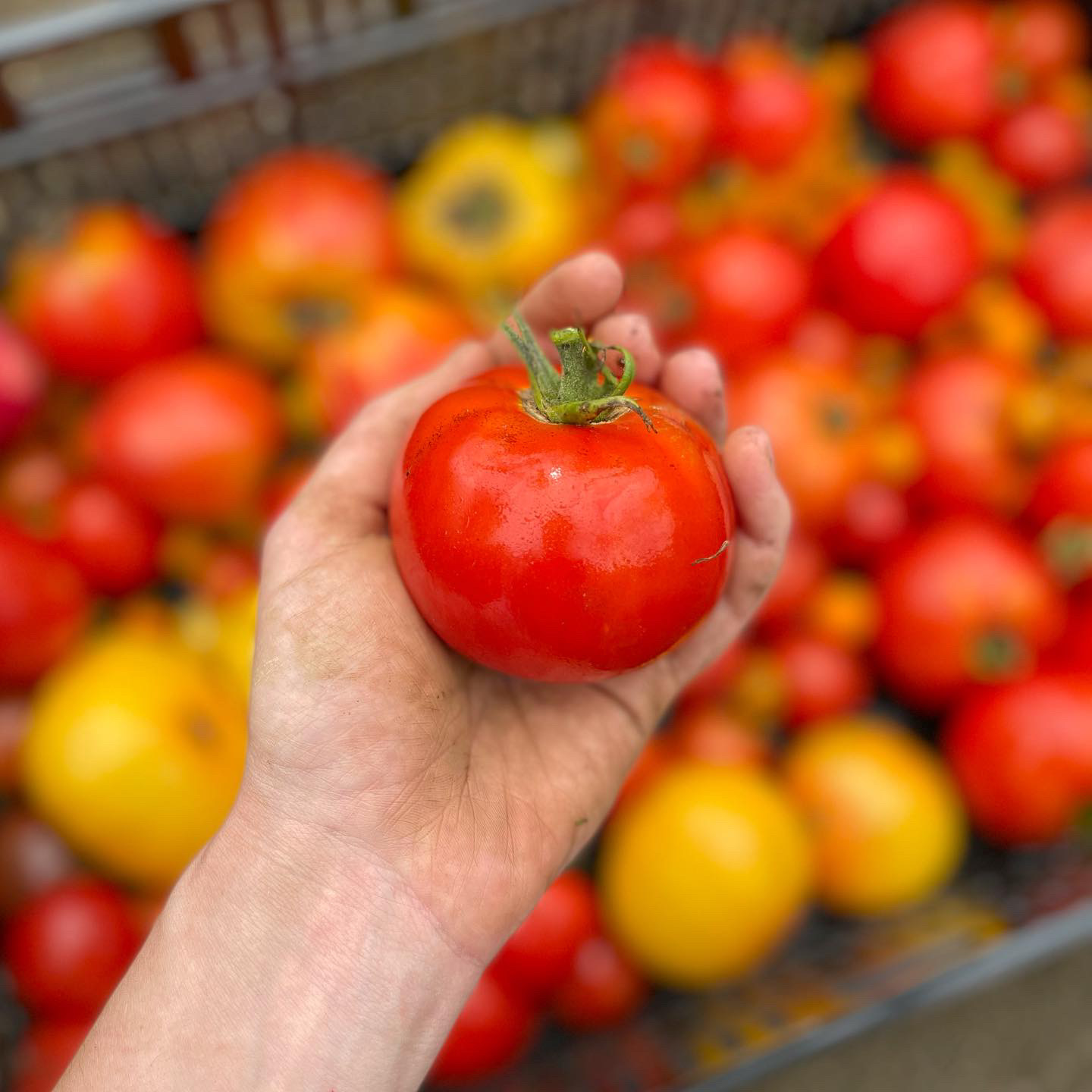
August inaugurates the harvest season and all the fruits and vegetables start to come back inside the house. Tubs of apples, crates of tomatoes, colanders of beans, and loose pumpkins litter the kitchen floor. The kids rifle through it, finding the largest apples to take one solitary bite of, swaddling the pumpkins in towels, and sorting the beans by color. Although this is preferable to last year when they absconded with my biggest squash, put it in their doll stroller and I didn’t find it for… several weeks.
September is the hedonistic height of fall, the bounty before the frost. Cold mornings warn us, but we don’t listen. We keep making applesauce, pretending the largess will last.
Tomatoes
I planted about 689 tomato plants, so I’m pleased to report that some of them did ok. We don’t get enough sun, nor do we have a long enough growing season, to rake in tomatoes, but we do alright.
Many of them get eaten fresh from the vine, many more become tomato/basil/mozzarella salad and the rest get canned as tomato sauce, of which Mr. FW made 19 quarts.
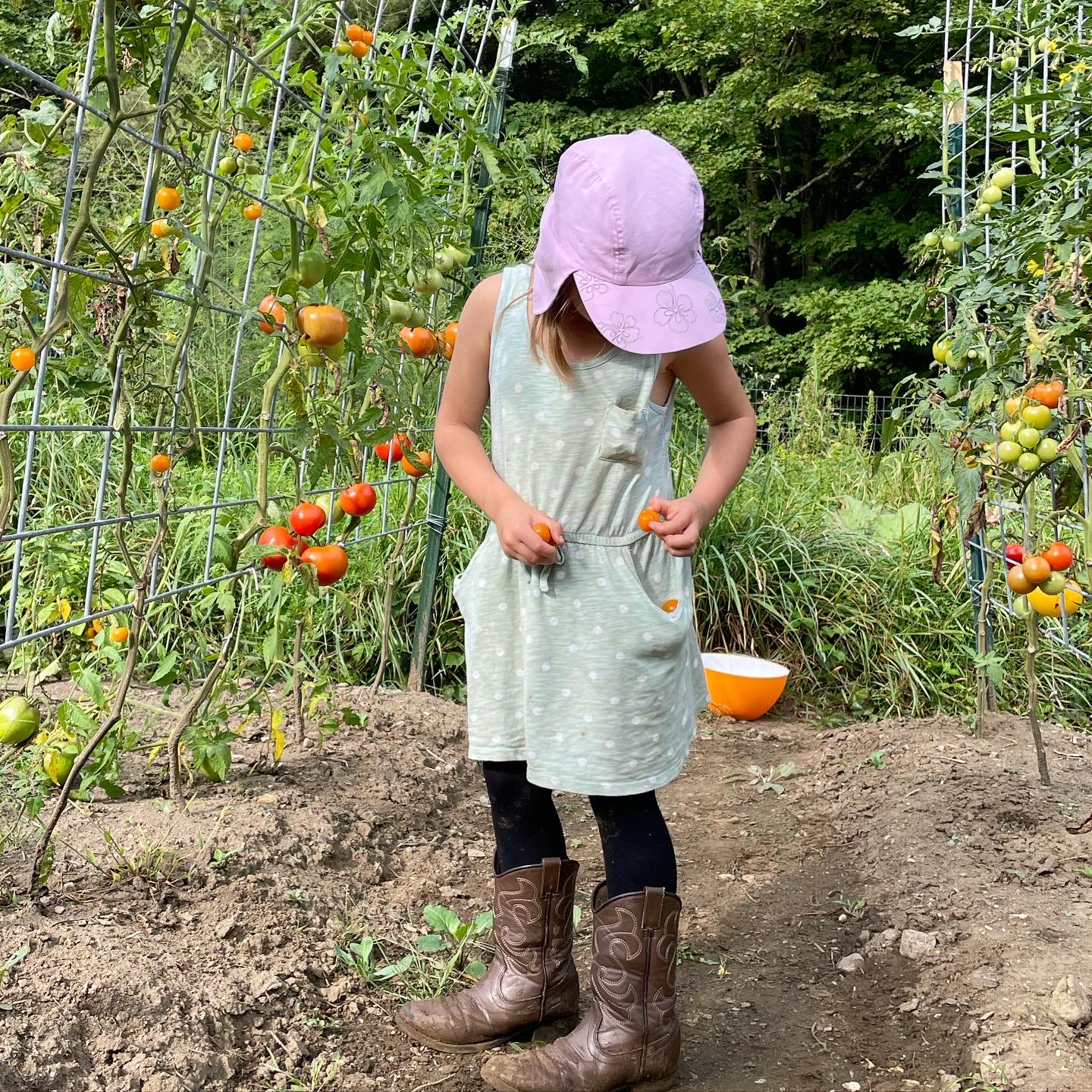
According to the kids, there are three options for tomato harvesting:
- Your pockets (that was an interesting laundry day, let me tell you)
- The actual harvest basket (too conformist; no one used)
- The direct-to-consumer, as demonstrated by Littlewoods’ chipmunk cheeks.
Bush Beans
My bush beans were prolific this year and I made 16 quarts of dilly beans using this recipe. My kids ate almost all of these quarts immediately. Can a child overdose on beans? Apparently not. The seeds were the Mardi Gras blend from High Mowing.
Currants
Our black currant bushes continue to thrive–they seem to love our climate and soil. Mr. FW made 16 quarts of currant jam. The kids have not yet eaten all of it, but they’re trying hard. His jam is 2 parts currant, 1 part sugar by weight.
Strawberries
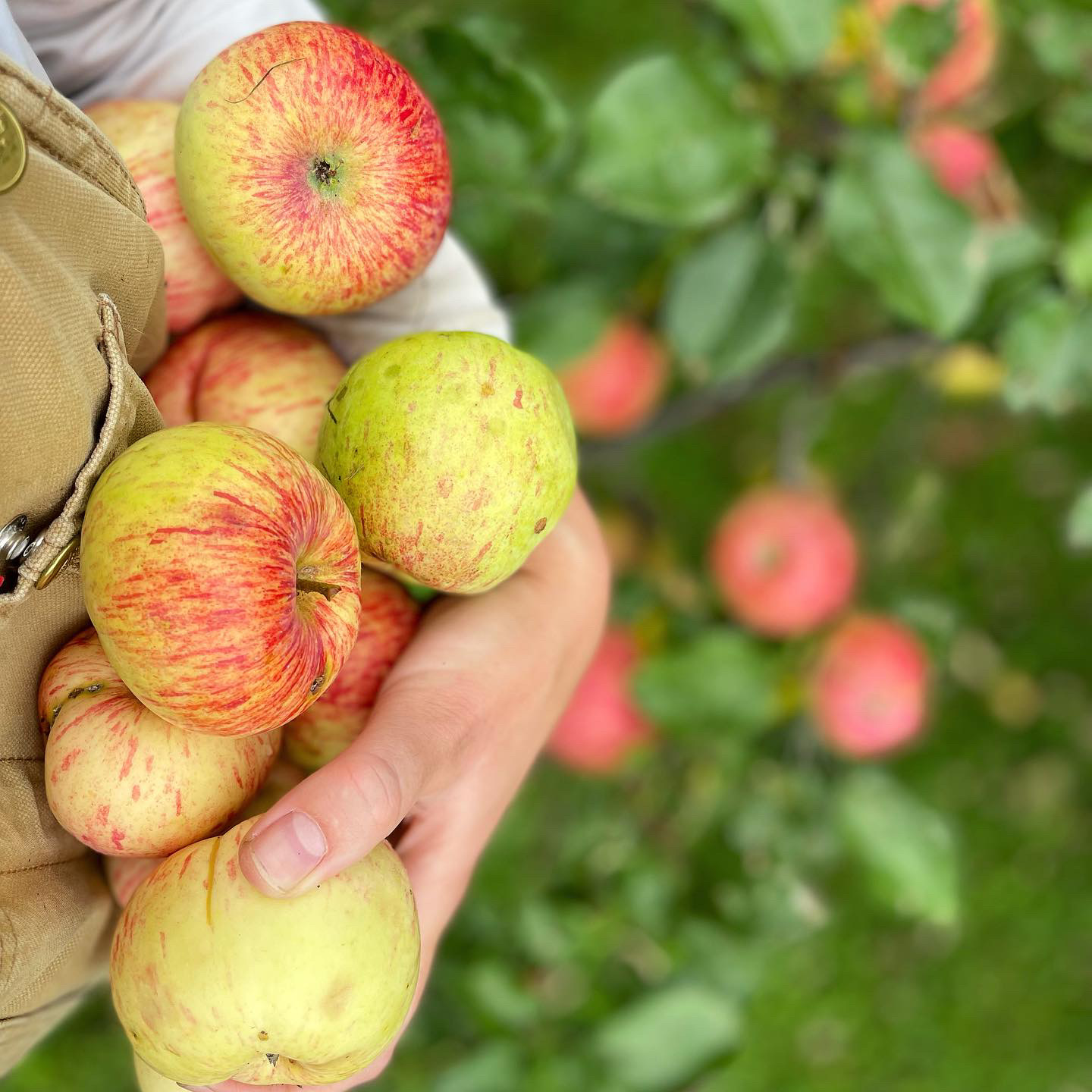
In their second year, our 100 strawberry plants did pretty well. We put bird netting over them, which helped deter overhead attacks. But chipmunks weaseled underneath the netting (despite it being tied down… ) and munched quite a few choice berries.
A family of garter snakes also took up residence in the beds and could be seen sunning themselves on top of the plants. Still, we got a lot of berries! I froze the minuscule amount that we didn’t eat straight from the patch.
Blueberries
Our three-year-old blueberry plants–all 28 of them–did pretty well this year, although it’s clear they’re not yet at the peak of their production capabilities. I had a hard time keeping the weeds down, which tells me we need to spread wood chips between the plants again. A fall chore, methinks. We still managed to harvest a lot of berries, but then again that’s relative when you have two little kids who will happily eat a quart of berries in an afternoon and then ask for more berries for dinner. As with the strawberries, I froze what wasn’t immediately devoured.
Blackberries

There’s a wild bramble of blackberries next to our lower field and the kids and I tromp through like mama bear and cubs every summer to pluck these gems.
It’s a thorny, messy job, but the berries are worth it. I managed to pick and freeze a lot of these to serve as wintertime bursts of summer.
Apples
Our apple harvest comes in two waves: the Red Duchess tree starts to ripen in August and the nine other trees ripen throughout mid to late September. Over the years, I’ve learned to use the Red Duchess apples–which also happen to be the sweetest and largest–for applesauce and dried apples. The rest we press into cider.
Littlewoods nominated herself as my preeminent, teensiest assistant for applesauce making and she was ON IT with the peeler/corer. So on it, in fact, that we managed to break one of our peeler/corers (from a yard sale) and had to move onto our back-up peeler/corer (found by the side of the road back when we lived in Cambridge, Mass). YOU NEVER KNOW when you might need your trash find peeler/corer.
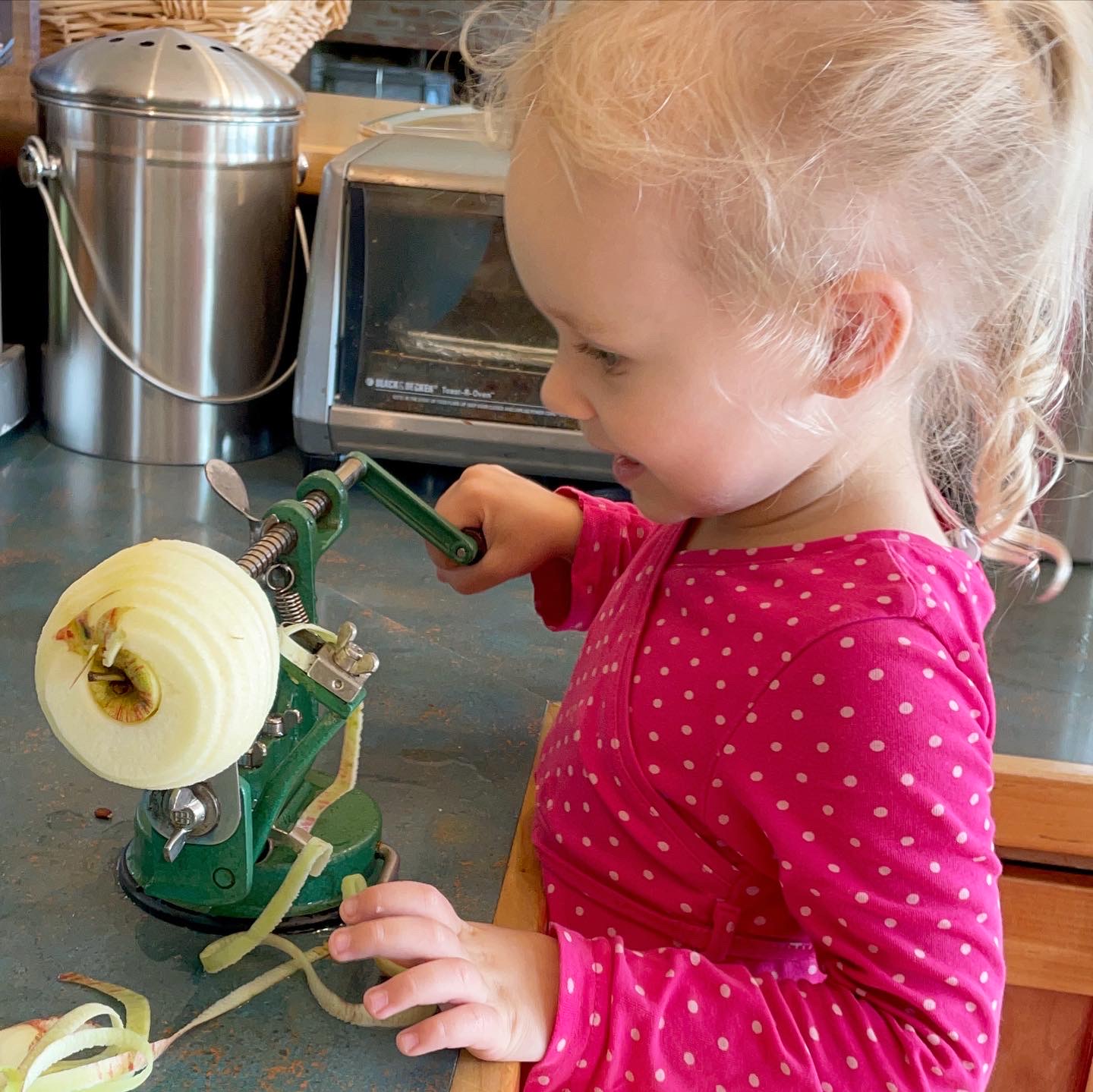
My niblet assistant and I canned 24 quarts of applesauce–using this recipe–and made an indeterminate number of dried apples. I sprinkle the apples with cinnamon before I put them in the dehydrator, which makes them divine and perfect for school lunches during the year.
Kidwoods started Kindergarten the week of this apple adventure and thus was not on hand to assist with apple activity, a fact reiterated to her by her little sister THE moment she got into the car at school pick-up. Listen, we all have to defend our thing. And in the case of Littlewoods, that thing is apples.
Salad and Herbs
My two raised beds of salad greens and herbs continued their abundance through early fall. There’s nothing like harvesting your dinner salad right outside your back door! Yum.
Chickens Start to Become Useful (sort of)
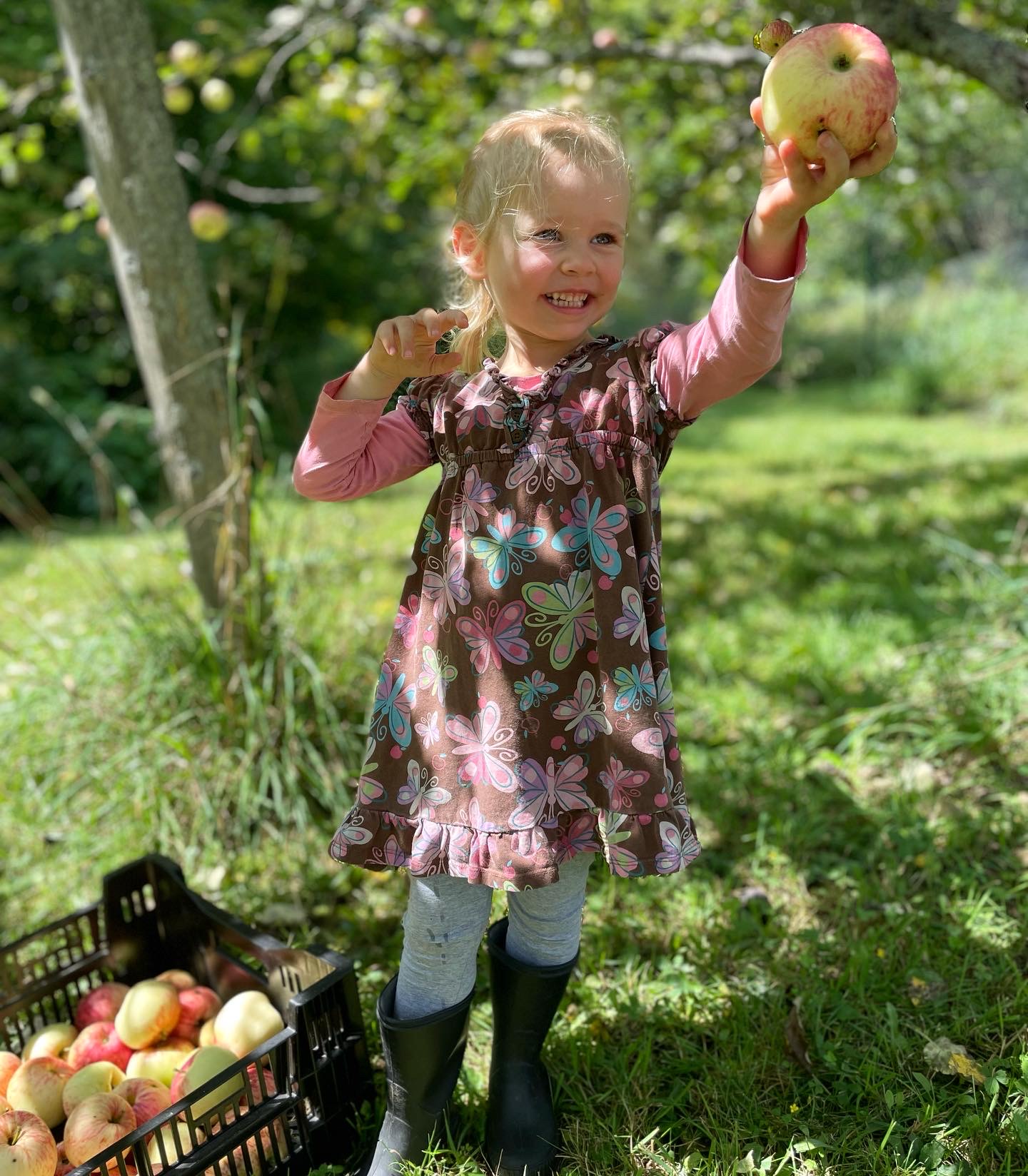
WE GOT OUR FIRST EGG IN SEPTEMBER!!!! All credit goes to Daisy chicken, the smallest of the flock, the first of her name, the Golden Comet with the heart of gold.
After laying it precisely in the nesting box, atop a soft bed of shavings, she announced her accomplishment with a flurry of boisterous bah-gocks and a fair amount of grandstanding. Littlewoods then squeezed the egg and Kidwoods dropped it, but it somehow remained intact.
As I shared the other day, not all of our chickens understand the memo on where to lay eggs, so we bought ersatz model eggs for chicken instructional purposes.
So far, the flock is averaging only 3-4 eggs per day when it should be more like 11 per day (that’s one egg per hen). And of course now the weather’s getting colder, which often equals a decrease in egg production.
We’re going to put a light in the coop soon so they’ll have the requisite number of daylight hours to facilitate laying. TBD.
Sugar Wood
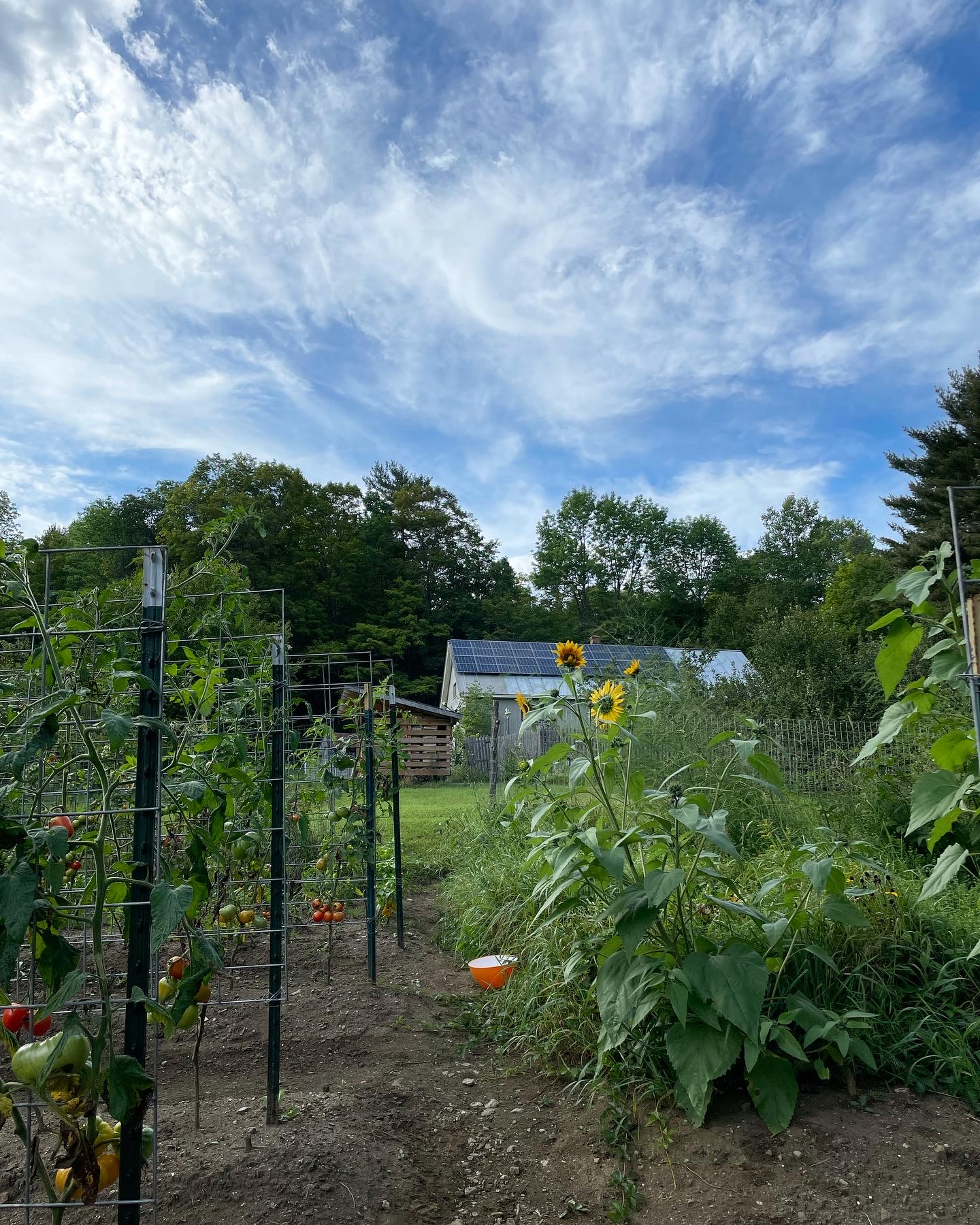
As summer wends its way into fall, Mr. FW turns his attention to wood. We burn wood in two ways around here: firstly, to heat our home with our woodstove and secondly, to boil our maple sap down into syrup in our evaporator. He starts off cutting the latter, known as sugar wood. Sugar wood differs from house wood and we store it in a separate wood shed.
Sugar wood needs to be faster burning and split thinner because you’ve got to have your sap boiling hot in order to make maple syrup. House wood needs a high BTU and it needs to dry and cure for several years (ideally) before you feed it into your wood stove. You want a slow, hot burn in your woodstove and a faster burn for your syrup.
Once he’s felled and split enough trees for sugar wood, he’ll move onto back-filling our main woodshed with house wood. We burn about three cords per year to heat our home and our shed holds nine cords total, enabling us to dry and cure the wood of future years.
Trail Clearing
Mr. FW’s other chainsaw-related summer activity is trail clearing. We have hiking trails crisscrossing our land–some of which were here, some of which we’ve built–and he has to stay on top of them to keep them open.
Some trails he can brush hog with the tractor, but most require him to hike with the chainsaw into the woods in order to remove fallen trees and branches. Worth it for the ability to hike right outside our front door!
Solar Update
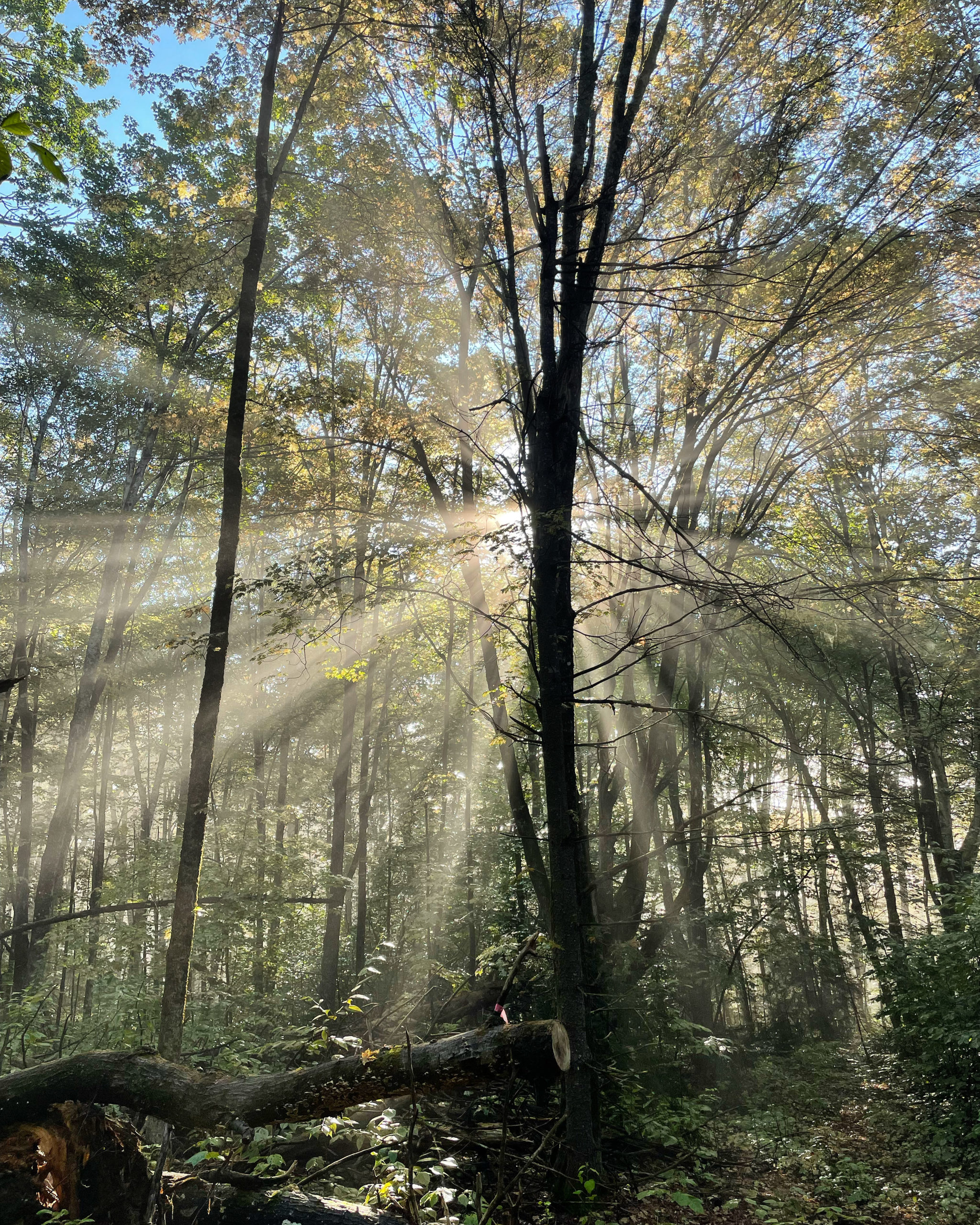
After moving here, we had solar panels mounted on our barn roof. My full write-up on the panels is here and I include a solar update in this series.
This is the only way for me to remember that: a) I have solar; b) you all would like to be updated on it.
- In August, we generated 691 kWh
- September brought 601 kWh
For context, in January 2021 our panels generated 95 kWh and in June 2021, we raked in 830 kWh.
Since our electric company offers net metering, we’re able to bank our summer and fall sunshine for use in the winter, which keeps our electric bill low year-round, even when the sun isn’t shining.
This has been your solar production update. You’re welcome.
Want More Fotos?!
While I only document homestead life once a month here on the blog, I post photos to Instagram and updates to Facebook with much greater regularity. Join me there if you want more of our frugal woods.
If you’d like to receive an email every time I publish a new post here on Frugalwoods, you can sign-up with your email address in the box below. No spam, just emails from me.


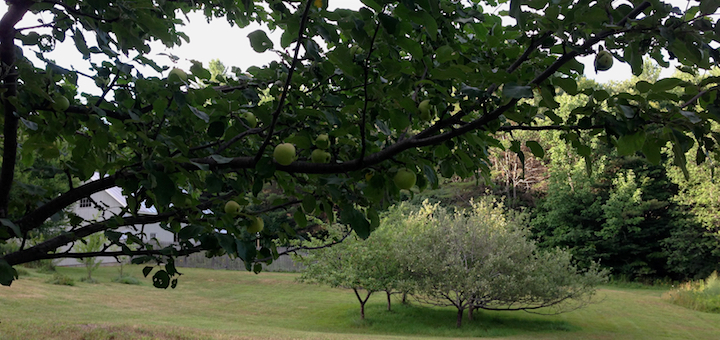
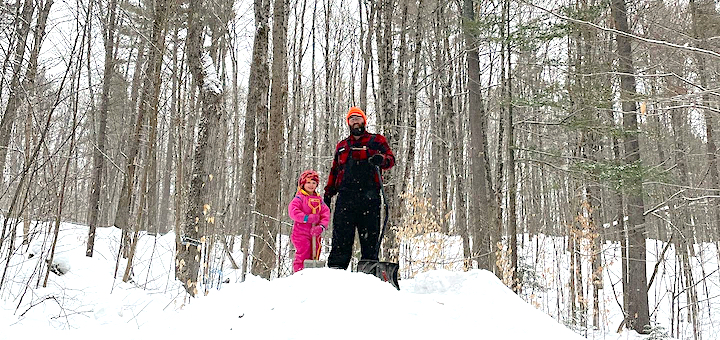

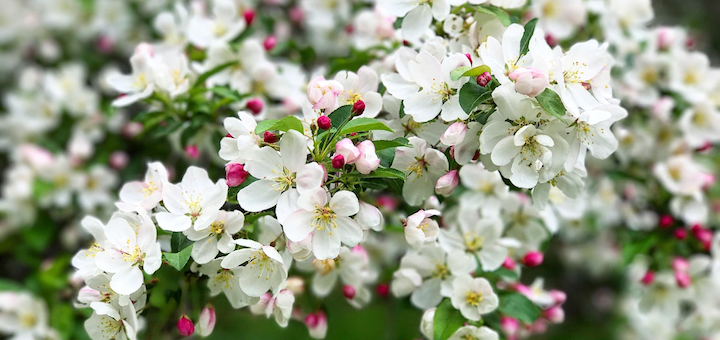
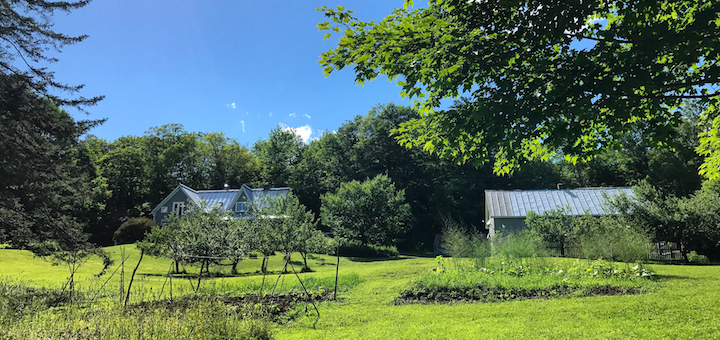

Looks delicious! I didn’t get around to doing anything other than freezing a pan of elderberries that are still languishing in the freezer, looking for a plastic bag to jump into. My strawberry plants also took over my whole life, and I have gone from “how can anybody complain about having too many strawberries?” to just pulling the plants up and throwing them in the basement, where they stay and die while I prented that I’m going to find the time to give them to a friend.
It is nice, living in a small community, isn’t it? I just hope that there are more and more jobs in rural spots, what with working from home and all. These little towns are so wonderful, and it would be wonderful to take them from more or less abandoned to thriving again…
Happy rest of fall!
I told a neighbor she could take x-y number of plants from one section of our patch (it got too thick) and all the daughters escaping the area as she wanted. We were out of town and when we got back, a stellar job. She could have taken a few more plants but I did agree escaping daughters were easier work. Then we had warm weather (for fall) and rain so hoping the transplants do well for her. If not, she can come down and pick again next summer.
Have you tried cherry tomatoes? Those often will ripen quicker than full sized, and might work better for your short growing season.
We do grow quite a few cherry tomato varieties, which our kids love to eat right off the vine! I also slice them in half for salads and to dehydrate. We love all kinds of tomatoes :)!
Although your daughter would be disappointed not to use the apple peeler gadget, you can make applesauce without peeling the apples. I just wash, slice them thinly, and cook them down with a bit of cinnamon and a couple tablespoons of water. Then I put them thru my Foley food mill. The peels make the applesauce a nice rosy color and all the peels get left behind in the mill. Then I fill Ziplock bags and freeze them flat.
You know, I made applesauce with the peels on last year and no one liked it! The kids claimed it was too sour and I found the flavor didn’t quite suit my baking needs (I often sub in applesauce for vegetable oil). I wish we liked it–it was certainly a lot faster to make!
I wouldn’t give up on the peels. I can see where it affects baking BUT remember your kids are young. I never peeled apples when dehydrating, making apple crisp, or eating as is. My kids never said boo. Perhaps a tad more sweetener or sell the fact you added more sweetener. For years I made “special fried potatoes”. They weren’t special, I just said they were. Kids ate them just the same.
I cook down my apples in the crockpot. By filling it three times, I have enough to can about six – seven pints of applesauce.
I agree with peeling- good for making pies and reminded me of my kids peeling with my mom in her mountain home. Have you considered strawberries above ground? Towers that can have netting more securely placed is an option and you can collect water in a container above them.
I also use the peels when I make apple sauce. I keep it simple. I just core the apples then chop them into smaller pieces. Fill a large pot with the chopped apples a bit of water and cinnamon and cook until soft. I let it cool a bit then use my immersion blender until most of the chunks are gone and it’s smooth. I tend to use the apples that arent in perfect for eating to make the apple sauce. It’s sweet without any added sugar and has a nice rosy color another poster mentioned.
Mrs FW- We have a small plot but all season we ate raspberries (and all else) to apples & figs. I would try to grow THORNLESS Blackberries – they do well in the Mid-Atlantic. We also added Paw Paw trees ( you need 2) delicious fruit native to our country. We use Best Girls.. we made a mistake with yellow cherries this year..to many and hard to pick and slightly mealy… we will skip cherry tomatoes next year= to much work!
Fair warning that chickens can also UN-learn being trained to lay in a certain place (insert laughing/crying emoji followed by real crying emoji right here). We had trained all of our hens to lay in their nesting boxes and then got some new chicks this year to add to the flock. A couple days of the new chicks laying their eggs wherever they so pleased and now THE WHOLE FLOCK IS DOING IT. Consider yourself warned 🙂
OH NO! CHICKENZZZZ! But yeah, I totally see that happening…. good luck re-training your girls!
Golden Comets are the best. We have one that we acquired at age 6. She laid eggs almost every day during the summer for 3 more years. She is now 10.5 and I think we will need to euthanize her before winter but we’re putting it off as long as we can, and I make her a little bowl of special chicken oatmeal with corn and seeds in the mornings.
Thanks for brining back good memories.
It’s been a bit since I made apple sauce, but my grandma taught me to leave the skins on too. My grandma would be running the cooking and canning pots on the stoves (cooking in the kitchen and canning in the basement) and all the aunts and cousins would be sitting at the table quartering the apples. The only thing we removed from the apples was them stem. After being cooked with some water, we ran them through the Squeezo Strainer (amazing tool that is mine since my Grandma has passed, I think they still make them) The sauce comes out the shoot into the jars, and the skins and seeds are pooped out the end into a bucket to be brought to the chickens or pigs.
We use our blackcurrants to make a bottled drink concentrate – really good diluted with boiling water in winter (high Vit C), or with lemonade or soda water in summer. Can be made from frozen blackcurrants.
Also boil up red apple peelings, adding a little stevia later, for a lovely summer drink with soda water.
Your tomato crop looks amazing. My crop here in Oklahoma had a horrible year. We had a cool/wet period during the height of summer that stunted them tremendously. Hopefully next year will be better.
Hi there, maybe an odd question, but curious how much time you spend daily on all of your gardens/trees/crops? It appears that y’all grow A LOT of food, and I just wanted to know what kind of time is invested daily, if you could guess, maintaining, weeding, picking, etc.
Thank you! Love your blog, newsletter and pictures on Instagram.
While artificially extending daylight with electric lights will encourage your chickens to lay more during the colder weather, it comes at a cost. Like us, chickens are born with all the eggs they will ever have so encouraging them to lay in this manner will mean they will have a shorter egg-laying life. Just something to consider. We prefer to let nature do her thing and accept fewer eggs in colder weather in exchange for having hens who lay well into their “golden” years. Some do as you are contemplating, and then cull their hens after about 2 years and replace them. Just another way of raising chickens but does require thinking about what you want and how you want to achieve that goal. Best of luck!
This is good to know–thank you for sharing!
Just want to say how beautiful your pictures and your tiny assistants are — lovely to look at and to read about your journey — thank you for sharing!
https://seedtreasures.com/ – open pollinated/heirloom seeds and quite few for shorter growing season (owners live, grow, and harvest in northern MN).
As for the egg production – do you have a rooster or only hens? Having a rooster has proved to be beneficial at my moms homestead!
Love all your stuff, but I love your garden updates the most! It’s my dream to one day have a homestead (or lifestyle block as we tend to call them here in New Zealand) but I’m pretty happy with my 1/4 acre town garden for now 🙂
Have you considered growing edible mushrooms in your woodchip mulch? Burgundy winecaps (Stropharia rugosoannulata) grow well in beds of wood chips ain sun or part shade and can help the growth of some plants, I’m setting up some beds this year for the first time
Thanks for sharing your wonderful life with us all. Now, for a boring question! What’s your freezer situation, how many and what type? Thanks!
Haha, not a boring question at all!! We have freezer conversations with our neighbors & friends alllll the time–especially those with big gardens and who hunt/raise meat! We have a regular fridge/freezer combo in our kitchen and a chest freezer in the basement, plus a mini-fridge. So far, this has worked out for us, mostly because we can a lot of what we preserve. We’ll probably need a second chest freezer at some point in the future…
Great info! Any recommendations on Fridge/Freezer brands? Your recommendation on Bosch Dishwasher was spot on. Thank you!
The hot air balloons look beautiful, what a fun experience!! I love seeing garden updates from other zones! You’re inspiring with the number of tomato plants you planted this year! I’m in zone 9 so I’m blessed with a long growing season. Waiting on it to cool off a little bit more to start planting for fall and I’m hoping it’s not too late due to the lessening daylight hours. Next week we have a 92 and then maybe the highs will be in the upper to mid 80s. Fingers crossed.
That’s interesting that you found applesauce cooked with the skins to be sour. I always assumed if the peel is good to eat fresh, it ought to be good to eat cooked, and not impart a sour or bitter taste to the sauce. When I make fried apples, I cook them with skin on, no sugar, and they are nice and sweet. You have a peeler, though, and an excited little operator, so by all means, keep on peeling and guarantee yourself some delicious applesauce 🙂 Not peeling is less work, but if you don’t like the results, it isn’t worth it to skip the peeling.
I have to fifth or sixth the suggestion to divide the nesting area. Our chickens always had individual boxes as well, back when we raised hens. We usually got a number of daily eggs equal to 80 to 100 percent of the hen population. I used to give eggs away weekly, and we ate eggs daily. We were on egg overload.
I started to get real nervous when I read bird netting and snakes in the same sentence. Snakes, and many other small animals, are easily entangled in bird netting. It is very difficult to get them out and they often die of exposure or stress before they’re found. Insect netting is a wildlife-friendly alternative or we’ve kept irresistible plants like strawberries in cages made of old window screens or hardware cloth (this also keeps out chipmunks). That might be a lot for 100 plants though!
Thank you for this, Melissa… I did not know that and always wanting to learn more to benefit us but not harm wildlife. Appreciate you sharing.
We have the same manual corer/peeler/slicer and this year we splurged on the Kitchenaid attachment. It is way faster and sturdier, and slices the apples more uniformly and thinly so they take less time to dry. We often use the peels and cores to make homemade pectin – after we’ve snacked all we want on the peels, there’s still plenty left over! We also use our applesauce as a base when we make homemade fruit leathers (50/50 applesauce/other fruit, usually a higher value fruit like berries or mango. Kids also like just apple fruit leathers)
Have you tried making apple butter with your apples? It’s sort of like a thickened applesauce with spices & canned. Very good on toast or biscuits.
Yes! It’s one of our favorites. We made so much last year that we didn’t need to make any this year 🙂
I loved reading about your harvest and what you’ve done with all the fruits of your labor! It’s a dream of mine to have a few apple trees (if not a small orchard) some day, so reading about your quarts and quarts of applesauce (and other apple goods) is inspiring!